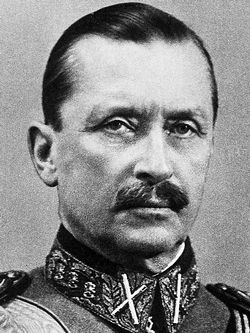
187 cm
Carl Gustaf Emil Mannerheim (Finland Swedish: [(kɑːrl) ˈɡʉstɑːf (ˈeːmil) ˈmɑnːærˌheim] , 4 June 1867 – 27 January 1951) was a Finnish military commander, aristocrat, and statesman. He served as the military leader of the Whites in the Finnish Civil War (1918), as Regent of Finland (1918–1919), as commander-in-chief of the Finnish Defence Forces during the period of World War II (1939–1945), and as the sixth president of Finland (1944–1946). He became Finland's only field marshal in 1933 and was appointed honorary Marshal of Finland in 1942.
The Russian Empire still dominated the Grand Duchy of Finland during Mannerheim's childhood, and Mannerheim made a career in the Imperial Russian Army, serving in the Russo-Japanese War and the Eastern Front of World War I and rising by 1917 to the rank of lieutenant general. He had a prominent place in the 1896 coronation ceremonies for Emperor Nicholas II and later had several private meetings with the Tsar. After the Bolshevik coup of November 1917 in Russia, Finland declared its independence on 6 December, but soon became embroiled in the 1918 Finnish Civil War between the "Whites", who were the troops of the Senate of Finland, supported by troops of the German Empire, and the pro-Bolshevik "Reds".
A Finnish delegation appointed Mannerheim as the military chief of the Whites in January 1918; and he led them to victory, holding a triumphal victory parade in Helsinki in May. After spending some time abroad, he was invited back to Finland to serve as the country's second regent, or head of state, from December 1918 to July 1919. Despite being a monarchist, he formally ratified the republican Constitution of Finland. He then ran against K. J. Ståhlberg in the first Finnish presidential elections in 1919 but lost and quit politics. Mannerheim helped found the Mannerheim League for Child Welfare in 1920 and headed the Finnish Red Cross from 1922 to his death. He was restored to a central role in national defence policy when President Svinhufvud appointed him as the Chairman of the Finnish Defence Council in 1931, tasked with making preparations for a potential war with the Soviet Union. It was also agreed that he would temporarily take over as commander-in-chief of the country's armed forces should there be a war.
Accordingly, after the Soviets invaded Finland in November 1939 in what became the Winter War, Mannerheim replaced President Kyösti Kallio as commander-in-chief, and occupied the post for the next five years. He became a unifying symbol of the war effort and part of the core leadership of the country. He personally participated in the planning of Operation Barbarossa and led the Finnish Defence Forces in an invasion of the Soviet Union alongside Nazi Germany known as the Continuation War (1941–1944). In 1944, when the prospect of Nazi Germany's defeat in World War II became clear, the Finnish Parliament appointed Mannerheim as President of Finland, and he oversaw peace negotiations with the Soviet Union and the United Kingdom. Already in declining health, he resigned the presidency in 1946 and spent much of his remaining life in a sanatorium in Switzerland, where he wrote his memoirs, and where he died in 1951.
Participants in a Finnish survey taken 53 years after his death voted Mannerheim the greatest Finn of all time. During his own lifetime he became, alongside Jean Sibelius, the best-known Finnish personage at home and abroad. According to Finnish historian Tuomas Tepora, a cult of personality began to be built around Mannerheim right after the civil war.
Given the broad recognition in Finland and elsewhere of his unparalleled role in establishing and later preserving Finland's independence from the Soviet Union, Mannerheim has long been referred to as the father of modern Finland, and the New York Times called the Finnish capital Helsinki's Mannerheim Museum memorializing the leader's life and times "the closest thing there is to a [Finnish] national shrine".
Source : Wikipedia